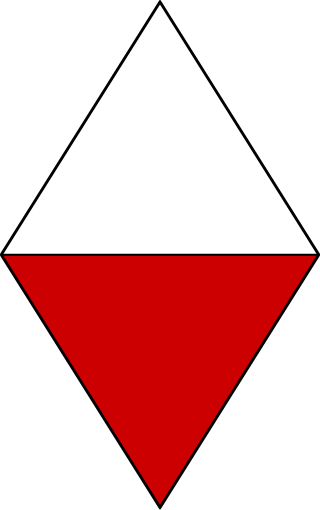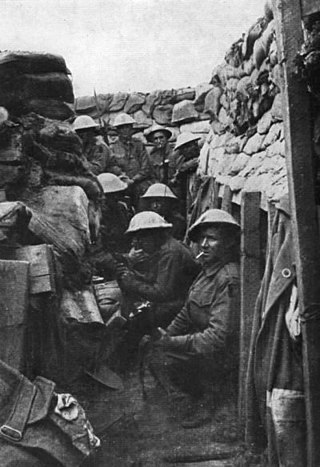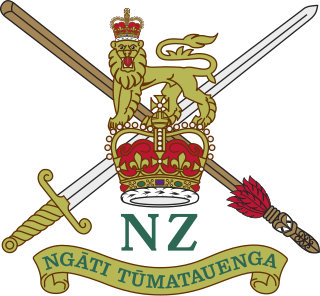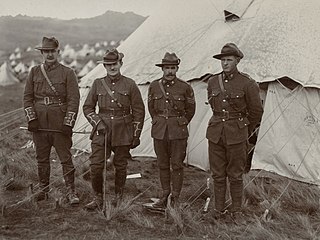Related Research Articles

The 10th (Irish) Division, was one of the first of Kitchener's New Army K1 Army Group divisions, authorized on 21 August 1914, after the outbreak of the Great War. It included battalions from the various provinces of Ireland. It was initially led by the Irish Lieutenant General Sir Bryan Mahon and fought at Gallipoli in 1915, Salonika, from 1915–1917, and Palestine from 1917–1918. It was the first of the Irish divisions to take to the field and was the most travelled of the Irish formations. The division served as a formation of the United Kingdom's British Army during World War I.

The 11th (Northern) Division, was an infantry division of the British Army during the First World War, raised from men who had volunteered for Lord Kitchener's New Armies. The division fought in the Gallipoli Campaign and on the Western Front. The division's insignia was an ankh or ankhus.

The New Zealand and Australian Division was a composite army division raised for service in the First World War under the command of Major General Alexander Godley. Consisting of several mounted and standard infantry brigades from both New Zealand and Australia, it served in the Gallipoli Campaign between April and December 1915.

The 42nd Infantry Division was an infantry division of the British Army. The division was raised in 1908 as part of the Territorial Force (TF), originally as the East Lancashire Division, and was redesignated as the 42nd Division on 25 May 1915. It was the first TF division to be sent overseas during the First World War. The division fought at Gallipoli, in the Sinai desert and on the Western Front in France and Belgium. Disbanded after the war, it was reformed in the Territorial Army (TA), in the Second World War it served as the 42nd Infantry Division with the British Expeditionary Force (BEF) and fought in Belgium and France before being evacuated at Dunkirk. The division was later reformed in the United Kingdom and, in November 1941, was converted into the 42nd Armoured Division, which was disbanded in October 1943 without serving overseas. A 2nd Line duplicate formation, the 66th Infantry Division, was created when the Territorials were doubled in both world wars.
The Australian Mounted Division originally formed as the Imperial Mounted Division in January 1917, was a mounted infantry, light horse and yeomanry division. The division was formed in Egypt, and along with the Anzac Mounted Division formed part of Desert Column, Egyptian Expeditionary Force in World War I. The division was originally made up of the Australian 3rd Light Horse Brigade, the reconstituted 4th Light Horse Brigade, and two British yeomanry brigades; the 5th Mounted Brigade and 6th Mounted Brigade.

The II ANZAC Corps was an Australian and New Zealand First World War army corps. Formed in early 1916 in Egypt in the wake of the failed Gallipoli campaign, it initially consisted of two Australian divisions, and was sent to the Western Front in mid-1916. It then took part in the fighting in France and Belgium throughout 1916 and 1917, during which time it consisted of New Zealand, Australian and British divisions. In November 1917, the corps was subsumed in to the Australian Corps, which concentrated all five Australian infantry divisions. After this, the corps was reformed as the British XXII Corps.

The New Zealand Expeditionary Force (NZEF) was the title of the military forces sent from New Zealand to fight alongside other British Empire and Dominion troops during World War I (1914–1918) and World War II (1939–1945). Ultimately, the NZEF of World War I became known as the First New Zealand Expeditionary Force. The NZEF of World War II was known as the Second New Zealand Expeditionary Force (2NZEF).

The Australian and New Zealand Army Corps (ANZAC) was originally a First World War army corps of the Mediterranean Expeditionary Force. It was formed in Egypt in December 1914, and operated during the Gallipoli campaign. General William Birdwood commanded the corps, which primarily consisted of troops from the First Australian Imperial Force and 1st New Zealand Expeditionary Force, although there were also British and Indian units attached at times throughout the campaign. The corps disbanded in 1916, following the Allied evacuation of the Gallipoli peninsula and the formation of I ANZAC Corps and II ANZAC Corps. The corps was re-established, briefly, in the Second World War during the Battle of Greece in 1941. The term 'ANZAC' has been used since for joint Australian–New Zealand units of different sizes.

The New Zealand Mounted Rifles Brigade was a brigade of the New Zealand Army during the First World War. Raised in 1914 as part of the New Zealand Expeditionary Force, it was one of the first New Zealand units to sail for service overseas.
The Otago and Southland Regiment (1948-2012) was a Territorial Force unit of the New Zealand Army. It saw service from 1959 to 1963 during the Malayan Emergency. In 1964 the unit was renamed the 4th Otago and Southland Battalion Group. The Regiments motto was Kia Mate Toa and Regimental Belt had the Mackenzie Tartan pattern of the Queen's Own Highlanders. The regimental badge uniquely contained a full Māori chief.

The Cameronians (Scottish Rifles) was a rifle regiment of the British Army, the only regiment of rifles amongst the Scottish regiments of infantry. It was formed in 1881 under the Childers Reforms by the amalgamation of the 26th Cameronian Regiment and the 90th Perthshire Light Infantry. In 1968, when reductions were required, the regiment chose to be disbanded rather than amalgamated with another regiment, one of only two infantry regiments in the British Army to do so, with the other being the York and Lancaster Regiment. It can trace its roots to that of the Cameronians, later the 26th of Foot, who were raised in 1689. The 1881 amalgamation coincided with the Cameronian's selection to become the new Scottish Rifles.

The Otago Infantry Regiment was a military unit that served within the New Zealand Expeditionary Force (NZEF) in World War I during the Gallipoli Campaign (1915) and on the Western Front (1916–1919). This Regiment and the Otago Mounted Rifles Regiment were composed mostly of men from Otago and Southland. The Otago Infantry Regiment represented the continuation of the Dunedin and Invercargill Militia Battalions formed in 1860.
The 5th Mounted Rifles was formed on 17 March 1911. It formed part of the Otago Mounted Rifles Regiment so they saw service during the Battle of Gallipoli, Egypt. They later served in France with the New Zealand Division and were the only New Zealand Mounted troops to serve in France.

The 7th (Southland) Mounted Rifles was raised on 17 March 1911. During World War I they formed part of the Otago Mounted Rifles Regiment and served in the Battle of Gallipoli and was then withdrawn to Egypt. They would later serve in France, with the New Zealand Division.

The 9th Mounted Rifles Regiment was officially raised on March 17, 1911. It was one of 12 regionally based mounted rifles regiments formed as part of the new Territorial Force (TF) organisation that came into existence on that day. This part-time Territorial Force and a tiny regular force of professional soldiers formed the basis of New Zealand’s army at the outbreak of the First World War.

The 10th (Nelson) Mounted Rifles, previously known as the 1st Regiment, Nelson Mounted Rifles was a military unit based in Nelson, New Zealand. They served in the Middle Eastern theatre of World War I and first saw action during the Battle of Gallipoli. As a part of the larger New Zealand Mounted Rifles Brigade they went on to serve in the Sinai and Palestine Campaign.

The Otago Mounted Rifle Regiment was a New Zealand Mounted Regiment formed for service during World War I. It was formed from units of the Territorial Force consisting of the 5th Mounted Rifles, the 7th (Southland) Mounted Rifles and the 12th (Otago) Mounted Rifles. They saw service during the Battle of Gallipoli, with the New Zealand Mounted Rifles Brigade and was later withdrawn to Egypt. They later left the brigade and served in France with the New Zealand Division becoming the only New Zealand Mounted troops to serve in France.

The New Zealand Pioneer Battalion (NZPB), later known as the New Zealand (Māori) Pioneer Battalion or New Zealand Māori (Pioneer) Battalion, was a battalion of the New Zealand Expeditionary Force (NZEF) that served during the Great War. The battalion was formed in Egypt in March 1916 upon New Zealand Divisional Orders of 20 February, and drawn from surplus officers and other ranks of the New Zealand Mounted Rifles (NZMR), the Otago Mounted Rifles (OMR) and the New Zealand Native Contingent (NZNC) then serving in Egypt with the New Zealand Infantry Brigade. It consisted of Māori, Pākehā and Pacific Islanders. "By the end of the war, 2227 Maori and 458 Pacific Islanders had served in what became known as the Maori Pioneer Battalion. Of these, 336 died on active service and 734 were wounded. Other Maori enlisted in other units."

The New Zealand Machine Gun Corps was an administrative corps of the New Zealand Military Forces during the First World War. It was formed in early 1916, following the Gallipoli campaign in response to a need for more effective machine gun support. The corps initially comprised independent machine gun companies and a mounted machine gun squadron, although in 1918 the machine gun companies were brought together into a machine gun battalion. The New Zealand Machine Gun Corps was disbanded at the end of the war.

The New Zealand Cyclist Corps was an administrative corps of the New Zealand Military Forces during the First World War. It was formed in April 1916, initially as a single company, but by 1918 had been expanded to a battalion of three companies. The cyclists saw action on the Western Front, but were controlled at corps level and generally did not fight with the New Zealand Division. The New Zealand Cyclist Corps was disbanded at the end of the war.
References
- ↑ "firstaif". Archived from the original on 24 July 2008. Retrieved 1 August 2008.
- ↑ "diggerhistory". Archived from the original on 27 April 2010. Retrieved 1 August 2008.
